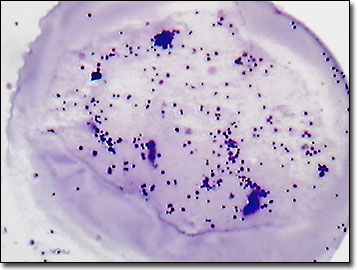Brightfield Digital Image Gallery
Human Male Chromosomes
In the normal karyotype of male chromosomes, 23 pairs of very long DNA molecules and their associated proteins carry the hereditary information of a man. The human haploid genome contains about three billion DNA nucleotide pairs divided among 22 pairs of autosomal chromosomes and one pair of sex chromosomes (XY).

Each chromosomal DNA molecule contains a telomere located at each end of the linear chromosome, a centromere, which attaches the DNA to the mitotic spindle, and a DNA replication origin. If the DNA helices were not highly condensed by small proteins, they would occupy too much space in the human cells. The tightly packed DNA units are referred to as nucleosomes.
In humans, it is the sex chromosome of the male sperm that determines the sex of the offspring. Because female sex chromosomes are characterized as an XX pair, no matter which part of the pair is represented in the haploid egg, it will be an X. However, with male spermatogenesis, there is a 50 percent chance of the sperm carrying either an X or a Y chromosome. If a Y-carrying sperm first reaches the fertile egg, the zygote will develop as a male (XY diploid). Likewise, an X-carrying sperm fertilizing a haploid human egg will result in a female offspring (XX). Some traits, such as red-green color blindness (dichromancy), are considered sex-linked traits, implying the mutation is carried by the sex chromosomes in the 23rd pair, and in this case, by the X chromosome. This explains why the recessive color blindness trait is predominantly expressed in male humans and why females are generally only carriers. For a daughter to exhibit red-green color deficiency, she would have to have parents that both carried the X-linked mutation in their genome. Additionally, her mother would also have to be color blind (double recessive), or if she were only a carrier, the daughter would have a 50 percent chance of being color blind.
Contributing Authors
Cynthia D. Kelly, Thomas J. Fellers and Michael W. Davidson - National High Magnetic Field Laboratory, 1800 East Paul Dirac Dr., The Florida State University, Tallahassee, Florida, 32310.
BACK TO THE BRIGHTFIELD IMAGE GALLERY
BACK TO THE DIGITAL IMAGE GALLERIES
Questions or comments? Send us an email.
© 1995-2025 by Michael W. Davidson and The Florida State University. All Rights Reserved. No images, graphics, software, scripts, or applets may be reproduced or used in any manner without permission from the copyright holders. Use of this website means you agree to all of the Legal Terms and Conditions set forth by the owners.
This website is maintained by our
Graphics & Web Programming Team
in collaboration with Optical Microscopy at the
National High Magnetic Field Laboratory.
Last Modification Friday, Nov 13, 2015 at 01:19 PM
Access Count Since September 17, 2002: 21586
Visit the website of our partner in introductory microscopy education:
|
|
